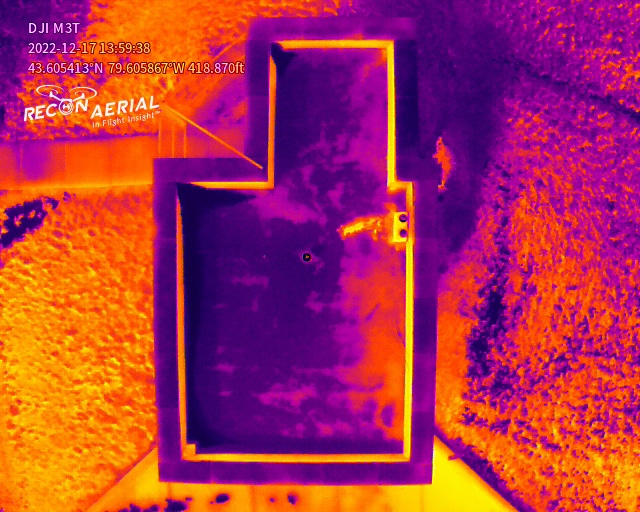
Thermal Roof Inspections
Thermal drone inspections integrate the mobility and accessibility of drones with the diagnostic capabilities of thermal imaging technology, offering unique benefits across various applications, from infrastructure and energy sector inspections to search and rescue operations. Here are the key benefits:
- Identifying Heat Variations and Leaks: Thermal cameras on drones can detect temperature differences not visible to the naked eye, making it easier to identify leaks in systems such as water, gas, or heating, as well as faulty electrical connections that may overheat. This capability is invaluable for preventive maintenance and ensuring system efficiency.
- Enhanced Energy Efficiency: By identifying areas of heat loss in buildings and infrastructure, thermal drone inspections can pinpoint insulation problems or areas where energy efficiency can be improved. This is crucial for reducing energy consumption and lowering operational costs.
- Improved Safety: Thermal drone inspections can be conducted without the need for personnel to access potentially dangerous or hard-to-reach areas, significantly reducing the risk of accidents and injuries. This is particularly beneficial for inspecting high-voltage electrical installations, tall structures, and hazardous environments.
- Early Detection of Faults: The ability to detect temperature anomalies allows for the early identification of equipment or structural faults before they lead to failures. This early detection is key to preventing costly downtime and ensuring the longevity of assets.
- Cost-Effective Inspections: Compared to traditional thermal imaging inspections, which may require scaffolding, shutdowns, or manned aircraft, drones offer a more cost-effective solution by reducing the need for extensive ground equipment and minimizing inspection times.
- Accessibility to Difficult Areas: Drones equipped with thermal cameras can easily access and inspect areas that are challenging or dangerous for human inspectors to reach, such as rooftops, wind turbines, and large industrial complexes.
- Rapid Emergency Response: In search and rescue operations, thermal drones can quickly cover large areas to locate missing persons or animals, especially in challenging conditions like at night or in dense foliage, where visual detection is difficult.
- Minimizing Downtime: For industries where operational continuity is crucial, thermal drone inspections can be conducted without the need to shut down equipment or halt production, unlike many traditional inspection methods.
- Environmental Monitoring: Thermal drones are used for environmental monitoring, including detecting forest fires, monitoring wildlife, or assessing water temperatures. They provide a non-invasive method to study and protect natural habitats.
- Data Analysis and Reporting: The data captured by thermal drones can be integrated into specialized software for detailed analysis, enabling the creation of comprehensive reports and historical data tracking. This aids in trend analysis, predictive maintenance planning, and compliance with regulatory standards.
Overall, thermal drone inspections represent a fusion of advanced technologies that offer enhanced diagnostic capabilities, safety, and efficiency, making them a valuable tool in numerous sectors.


0 comments